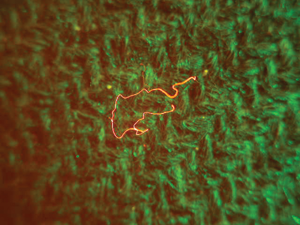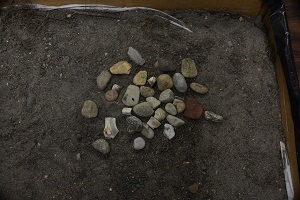
Two light illumination methods can be employed to locate hair and fibers with a forensic light source. First, oblique or parallel lighting of a surface such as a floor or carpet with a strong white light (the more powerful the better) will reveal small particles like hair and fibers for collection. Second, some hair and fibers will also fluoresce under UV or visible light and will stand out strongly for collection. For the best chance of collecting the maximum number of hair and fibers at the crime scene, you need a powerful light source that offers strong White light illumination as well as strong UV and visible wavelengths; all of which are available only in a forensic light source.
 |  |
Fiber on fabric chair; left SP540nm illumination no camera filter, right with orange camera filter. | |
Fibers may or may not fluoresce. Organic fibers may have a better chance at fluorescing than synthetic fibers but that is only a generality. While organic fibers have the natural chemistry to fluoresce many synthetic fibers may fluoresce due to construction or creation processes (stretching, weaving, stressing).
Regardless of the reasons why a fiber fluoresces on a particular background, that detection and collection is what is desired. It may not be readily determined what the fiber is but it can be said that the fiber that fluoresces differently than the background does not belong there and typically it is worth collecting. Once collected there are a number of tests and analyses that can be performed in the lab to determine identity of the material.
Hair typically does not fluoresce on its own. If it does, many times the fluorescence is too faint to be seen by the naked eye. Some dyed or bleached hair may fluoresce because of the chemical treatment the hair is exposed to. Many times hair is detected using oblique lighting. The light from a light source being held at an angle parallel to the surface and the hair may stand out in three dimensions.
Many drugs and controlled substances fluoresce naturally when exposed to an alternate light source. However this fluorescence is not necessarily the primary method of detection. That is to say you would need a lot of the material in a particular area to see it as significant. Many times it is a combination of fluorescence of the material as well as the use of oblique lighting that would allow the user to see a significant signal for collection. As with most alternate light source applications, it is not likely the light source will identify what the substance is but, provide the detection and realization that the substance does not belong where it was found.]
 |  |
Fluorescent particles on table; left SP540nm illumination no camera filter, right with orange camera filter. | |
Shoe prints and impressions may be detectable with oblique lighting depending on the surface they are deposited. While their detection works best on smooth non porous surfaces such as linoleum tile, or hardwood floors, the relative cleanliness of the surface also matters. Heavily trafficked areas also may have rougher or worn surfaces that may impeded the clear detail of a dust impression. Following is an example of oblique lighting with a Handscope Xenon;

Dust impression of shoe on floor tile; White light illumination, no camera filter.
Bone and teeth also exhibit a natural fluorescence. This may prove useful in the detection of remains from sites in the environment. While some rocks and much of the plant material in the environment also fluoresce, the bone and teeth exhibit a pronounced and in many cases a uniform fluorescence. That is to say the entire fragment will uniformly fluoresce, while most rocks that exhibit a fluorescence will have fluorescent layers or lines (striations) that will fluoresce markedly different from the bones. As with all animals decaying tissue may also fluoresce under the right conditions.
 |  |
Mixture of bone and rocks; left visible light, right SP540nm with Orange goggle | |
 |  |
Tooth; left White light without camera filter, right 440nm illumination and Yellow camera filter | |
 |  | |
Mixture of bone and rocks; left visible light, right 460nm with Orange goggle | ||
 |  | |
Fingernails; left White light no camera filter, right UV (300nm-400nm) no camera filter. | ||
Spectromètre Micro-Raman - Microscope Raman Confocal
Microscope d'analyse X (Micro-XRF)
Do you have any questions or requests? Use this form to contact our specialists.
